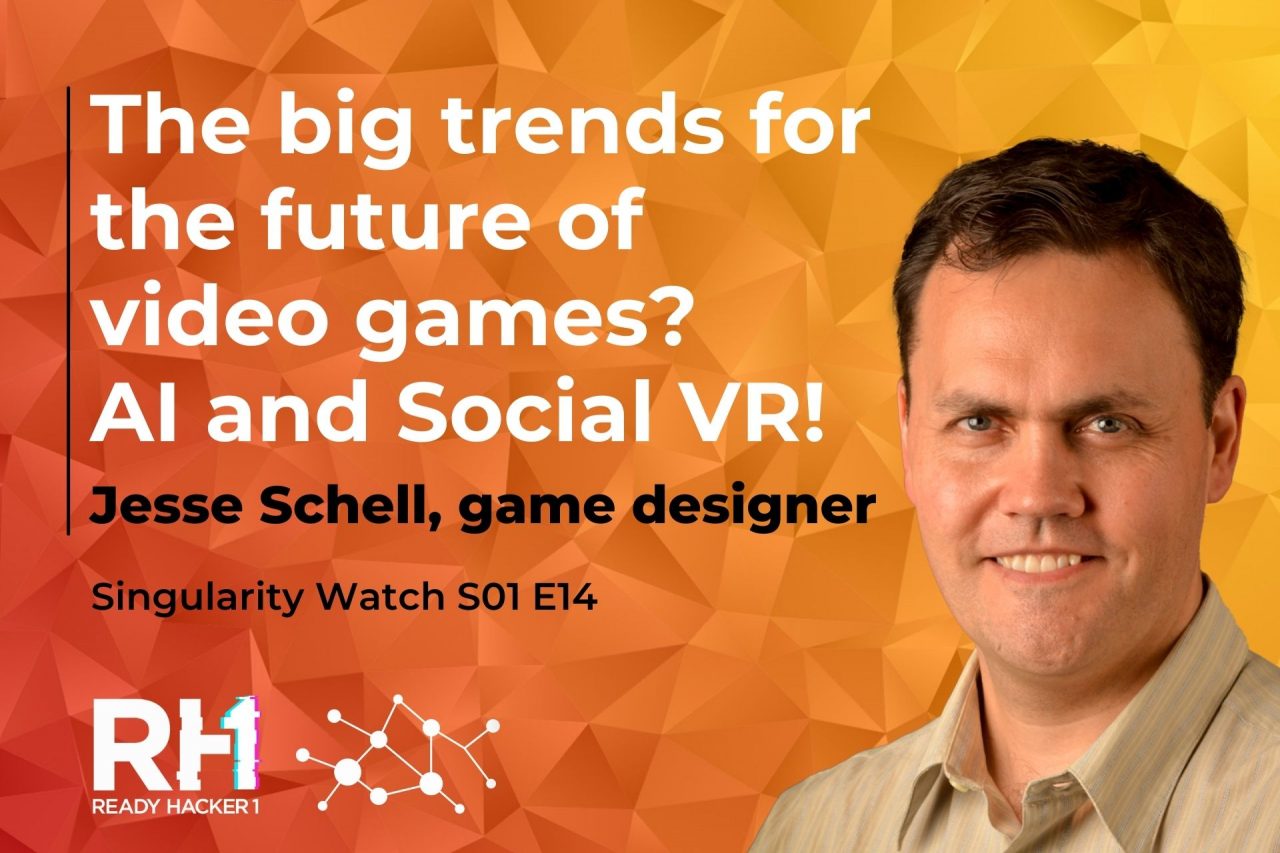It’s easy to say “game.” But a game doesn’t exist without someone who plays and enjoys it. A game does not exist without the experience of playing it.
Jesse Schell — founder of Schell Games and author of highly successful games such as “Toontown,” “I expect you to die,” and “Until You Fall” — undoubtedly has this concept in mind.
In this episode of Singularity Watch, we immersed in discovering what it means to create games and video games, the risks and challenges, and what will transform the world of video games in the next ten years.
Oh, and together with Jesse, we also discovered what the nightmare object is even for an experienced video game creator like him!
Tim: In the Netflix docu-series “High Score,” at the beginning of the first episode, Howard Scott Warshaw says: “As a game designer, it’s not about what I’m putting on the screen, and it’s not about what’s in my design. It’s about what’s going on in the head of the player”. Do you agree with this statement?
Jesse: That’s absolutely true. Games are nothing all by themselves. A game is an inert object if nobody plays it. If it just sits there and isn’t played, it’s almost like it doesn’t exist. We don’t really care about games as designers; we’re not making games because games are something we care about. We’re trying to create human experiences, and games can foster and encourage certain kinds of experiences. All we care about is the experiences. If I could just go into people’s minds and just help and create experiences directly, I would do that. But you can’t, and games are a great way to be able to do that. So, I think the creator of Yars’ Revenge is right.
Tim: What kind of experiences are you looking for?
Jesse: Usually, you’re looking for experiences that are ones you couldn’t have in your everyday life. That’s what people are looking for out of games: ways to have experiences that kind of take them out of who they usually are and what they typically do. And those can be physical experiences, social experiences, experiences of kind of puzzle-solving, and success. There are so many ways you can do it, and the ones I like best are the ones that help you become a better version of yourself.
Kavya: Kavya: Jesse, you teach Game Design and Building Virtual Worlds at Carnegie Mellon’s Entertainment Technology Center since 2002. So, you’re deep into the idea of games themselves. If you had to choose a title for a docuseries about videogames, would you have gone with “High Score” as well? I mean, is that the idea that summarizes the concept behind games?
Jesse: High score is a good title because it speaks of aspiration in the world of video games. I think that’s a totally appropriate title. Not every game is about scoring, of course, but every game is about some kind of aspiration of trying to do something, trying to be something. I think that’s true for every game.
Tim: I love that video games, like every other form of communication or art, it is about creating, it is about experiencing, it is about aspiring to something more, and it’s strongly related to the audience. So, it’s particularly important to think about the age of your audience. What are your key principles when it comes to age-appropriate design in gaming?
Jesse: Age is one of the things that define what people are aspiring for, what they’re trying to do, and what they’re interested in, not to mention how they communicate and who they want to connect with. A lot of it is just understanding the psychology of where people are when they’re at different ages. We obviously have many different segments when we talk about children, and children’s age ranges are very much defined by brain growth. You often hear people talk about 0 to 2, or 2 to 5, 5 to 7, 7 to 9, 9 to 12. Those aren’t made-up numbers. We don’t say 7 to 9 arbitrarily. We say that because there are precise points at which there is brain growth. You can go back 2000 years and hear people talking about “age seven” as the “age of wisdom.” This is because particular brain growth happens right around that age that lets you start to reason and discuss things in a way that a five or six-year-old just simply isn’t capable of. So, when you’re younger, the games you aspire towards are very dominated by where your brain is. As you get older, it changes because your brain stops going through these growth phases at about age 23. So, obviously, we see significant changes into the teenage years: teenagers are interested in communicating in ways that they haven’t before. They’re interested in experimenting with identity in ways that younger people have been less interested in. With older people, everything is dominated not by brain growth because now the brain is stable, but by who they want to interact with. It is about that they want to interact with their family, that they want to interact with their friends, that they’re trying to do something kind of personal for self-care, and that they need a respite from all of their social responsibilities. There’s a lot to focus on there. And then one of the things that I think people don’t think about enough is designing for multiple age groups to interconnect. So people talk about the principles of games for children, but very few people talk about the principles of games for families because designing a game for families is very different. I’ve had a lot of experience on a game called Toontown Online, one of the first MMOs for kids. We, very intentionally, tried to use the psychology of inter-family communication to find easy, convenient, and comfortable ways for families to connect with each other through technology. So it’s something you have to think about all the time.
Tim: When you’re designing and developing these games, do you have any aspect for building something with those parents in mind who are concerned for the safety of their children?
Jesse: When you’re designing anything for children, safety always needs to be paramount. Partly because it makes the parents feel better, but also partly it’s just your ethical responsibility. Most of the time, when you’re making a game, you don’t worry that if you do it wrong, someone’s going to die. But when you’re making social games for children, if you do it wrong, someone’s going to die, and you have to think about that. When we first started working on Toontown, to help ourselves focus on this and get to make sure we were really responsible, we had one of the artists draw a cover of Time magazine with the news that someone got kidnapped because we made a mistake in our game. We all looked at that because we wanted to remember that we had the responsibility in our hands. When people think about safety, they think we need to protect people from language. Still, language isn’t going to hurt anybody. The language might be awkward or uncomfortable or weird, but it’s not going to hurt anybody. What’s going to hurt people is children who don’t understand they shouldn’t be giving out personal information to a dangerous person. And that dangerous person kind of encounters them in real life. So however you do it, you have to take these things very seriously. When we made Toontown back in the day, it was definitely the foremost concern.
Kavya: What’s the first game you played?
Jesse: Oh boy. I’ve played games my whole life, and I almost feel like every game I played made some kind of impression on me because I was just always fascinated by games of all kinds. I remember the first time playing Avalon Hill’s war games with my father when I was a kid, and those were absolutely fascinating. Even simple and little board games, or card games, really intrigued me growing up. My friends and I were always making new ones, and I remember one of my really formative experiences. I was maybe seven years old, my brother was maybe four years old. He woke up one morning, and he said, “I played a card game in my dream, and we should play it right now.” And it was this game called Thunder, and it was all about getting twos, and twos ended up multiplying your power. The idea of making up a new game in a dream and then playing it in the real world was a moment I always remember and think about because making new games is just so much fun. I was lucky to live during the 70s and 80s when we went from a time where video games didn’t exist to suddenly they were everywhere. Suddenly we had arcade games, we had game consoles, and we had home computer games. And then modems showed up, and just being able to live through all of that invention has just been very exciting. And, of course, the invention isn’t stopping.
One of my big hobbies is juggling. I used to be a professional juggler, and I worked with magicians. When I look at all the things I’ve been interested in over the years, things that seem magical and game design is so magical because you start with nothing. You go from some cards or little bits of cardboard or just a computer, which could be the most boring thing in the world. You create these entire fantasy worlds that people engaged with emotionally and deeply in their minds. It’s a wonderful thing to be able to work on. I spent the morning today, like the first thing I woke up, thinking if I could make a game where you drive an ice cream truck and what that game would even be like. It’s just so fun to be able to think about things like that.
Tim: is there a video game you would like to forget about just to be able to play it again?
Jesse: I think Portal, Portal, or Portal 2, probably Portal 2. That was just so fun exploring every little bit of that. Another one, I think it was Blast Corps on the N64. I fell deeply in love with that game and squeezed all the juice out of it, and I would love to be able to do it again.
Kavya: Is there a video game you would like to forget about and never touch anymore?
Jesse: I don’t know if I would like that because there are lessons to be learned from every game. Even the worst, most horrible game, you don’t want to forget it because you don’t want to make those mistakes again, and you want to warn people away from them. I can certainly think about games I’ve worked on where I wish we had gone a different direction. I wish we’d done something different, but at the same time, like that’s how you learn.
Kavya: Let’s get more personal. What’s the best video game that you ever created?
Jesse: That’s a tough question because it depends on what you mean by best. Toontown might be that game. We’ve had such an intense focus on creating a social experience, and there were an awful lot of things that it feels like we did right in that game. At the same time, I look at “I expect you to die,” which is a VR puzzle-solving game. I’ve been able to take 20 years of VR experience and help channel it into that. And we’ve had such a beautiful team working on that. It’s a tough call because everything you work on, there’s something that you love about it.
Tim: Many people say that the most difficult object to create in a video game is a door. What is your nightmare object?
Jesse: I don’t know if doors are that bad. I get what people are talking about. For me, it’s the ropes. I know that sounds crazy, but making ropes behave like they do in real life is just surprisingly and weirdly hard. When you think about all the things that rope can really do and how they bend, flex, and the business of tying knots and all of that, we just don’t know how to do it, and they can lead to disappointment. I’m always fascinated by the objects we choose to avoid in games because we don’t want to deal with them, so we act like they don’t exist. Fluid simulation is the thing we just don’t do in games because it’s so hard. We ended up making a game all about a chemistry lab. It was a game show set in a chemistry lab. We’ve got to show off your awesome lab skills, and we thought this would be a great educational game for VR. The answer was, “don’t do that.” We had to invent so much fluid stuff because since it’s hard, people don’t do it, even though fluids are such a normal part of everyday life. The whole idea of making something where you can do a reasonable simulation of pouring from one glass into another, well, the physics just aren’t there.
Kavya: You graduated in 1994 with a Master of Science in Computer Networking and Virtual Reality. What was VR in 1994?
Jesse: The crazy part is VR has changed very little in all this time. We still have six degrees of freedom, head trackers, hand trackers. There were more wires, and the computing hardware was a lot more expensive. So, for example, when in 1995, when I was working on DisneyQuest, we were working on the Aladdin’s magic carpet VR experience. For Disney, we were doing 3D worlds with 3D animated characters. The characters had approximately 3,000 or 4,000 polygons in them, which isn’t that different from what we do now on the Oculus Quest. The difference is that the hardware we were using was $500,000, whereas now you can get all the same stuff for about $500.
Interestingly, the features aren’t that different, but the cost is 1,000 times less. I’m not going to say there’s no difference because things today are lighter, better, cheaper, and faster. We have shader algorithms, we have many things that didn’t exist before, but the basics of what you do and how you do it haven’t changed that much.
Kavya: What can you tell us about the future? What are the game trends that people really can’t see yet?
Jesse: There’s a lot of trends going on in the VR space. The big one that’s coming is social. We’re going to see this big explosion of social because there’s a magic number which is 10 million. When there’s less than 10 million of something, probably none of your friends has it. When there’s more than 10 million of something, perhaps at least one of your friends has it right now. In terms of VR headsets, we’re in the “less than 10 million” zone. So, for most people, none of their friends have it, and so it’s not a meaningful social experience. Once we cross over, suddenly, we’re going to start to see that happen. And because there’s so much power in social VR because of this feeling of presence, that’s going to start to become a really big deal. I’m expecting to see that around 2025. Some of the other stuff that’s coming that people aren’t thinking about it has to do with AI: we’re getting so close to a tipping point where computers can understand the spoken word, understand what we’re actually talking about, and then they have to be able to engage in the rhythm of human conversation. So, when you look at stuff like Alexa, Alexa understands your words, sometimes it understands what you’re talking about, but it understands nothing about the rhythm of human conversation. It’s going to be the game developers who have to do this and figure it out because once we have that, we’re going to be able to have an intimacy with characters that we’ve never had where you can talk not like you’re giving orders to a dog like you do with Alexa. Still, you’re going to speak with AI characters like you’re talking to another person, and they’re going to respond like a person does. The emotional experience created by that will change the medium of video games fundamentally. I think we’re gonna start to see experiments with that around 2026-2027, and I think we’re going to begin to see really take hold, maybe around 2030.
Kavya: What does singularity mean to you?
Jesse: I think the singularity is the time when we can no longer predict the future at all because things are coming at us too fast. Let’s say you lived in the year 1100, and I asked you to make predictions about the technologies of the far-off year of 1200. You’d probably do fine, actually, because the technology was moving so slowly then. Suppose I ask people to tell me about technologies in the year 2100. In that case, people really struggle because they can’t imagine out that far. And even now, asking people to think about five or ten years, people struggle. We’re gonna get to the point where I can’t imagine one year, I can’t imagine six months, I can’t imagine one month, I can’t imagine tomorrow because it’s going to be coming at us too fast. And I think a lot of that will have to do with what AI turns into the intersection with biological technologies. That’s going to force everyone to confront what does it actually means to be a human being. We’re going to see those two things happen at once because we will have the biological stuff happening where we do all this sort of gene manipulation. Then we’re going to also have these AIs showing up, and human beings always assume that everything is like a human being. That’s just how we are. So, we presume AIs will think like human beings. Still, they don’t because human beings, everything we do is defined by death, write everything that we value is about the fact that we’re going to die one day. And we got to be careful not to die, and we got to be careful to do this and that before we die. AIs don’t care about any of that. And so their way of thinking is going to be completely different. And so it’s going to make us realize what it actually means to be human. A lot of people get weird about it, and they get all dystopian. Still, I think we’re gonna see a lot of really positive human growth as people start to understand what does it really means to be a human being.
Tim: As you said, you are also a performer, juggler, comedian, and circus artist. Can you predict the future and tell us, please, when do you think we’ll be able to learn juggling in VR?
Jesse: I’ve been thinking about that a lot. I and some other jugglers who do VR have talked about this, and I’ve been thinking about doing more with it because part of the problem is throwing in VR doesn’t work right now. I think it’s because people haven’t thought enough about the tactility of throwing and how it actually works. I’ve actually been thinking seriously about creating a juggling app. I’ve taught thousands of people to juggle, and I think it would be very possible to make a juggling app. Still, first, we’ve got to get the throwing and catching and the object motion right and correct. There’s a lot of details in it about the way that the human mind processes parabolic paths. I know it sounds crazy, but we have a lot of special stuff in our brains about how parabolas work, how catching works, and how we move our hands. The advantage you have in VR is that you can move objects in slow motion. So many people learn to juggle using scarves because the scarves move in slow motion in real life. But to gradually shift the speed of the objects moving closer and closer to real-time motion, that could be a way to learn juggling very fast. I’m hoping to explore but haven’t explored yet.
Kavya: It’s like the industrial age and the stone age at the same time where we are breeding touch.
Jesse: It’s a beautiful time for invention. There are so many things that are being created and experimented with now that are just going to be defining the next few decades. And so, if you like inventing things, it’s a beautiful time to be alive.






